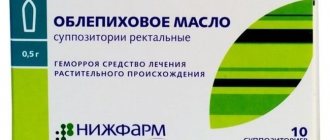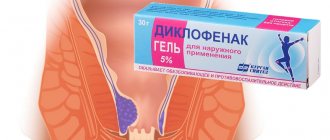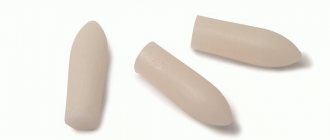Dysbacteriosis is an unpleasant phenomenon that does not manifest itself externally, but causes unpleasant sensations inside. The intestines, mouth, vagina are populated by specific microflora, some of which are harmful, the other - beneficial.
Any negative external factor or pathology can disrupt the idyll. The symptoms of dysfunction are too bothersome, which forces a sick person to look for effective suppositories for dysbiosis. It is difficult to decide where to choose, since there is a large variety on pharmacy shelves, and advertising is often misleading.
Description of the disease
Ebiosis is an optimal set of bacteria that does not cause discomfort to the body through its vital activity. Under the influence of various factors, the number of beneficial bacteria may decrease. Aggressive microorganisms colonize the space and cause concern.
Causes of imbalance:
- stress;
- suppressed immunity for various reasons;
- change in gastronomic habits;
- intoxication;
- antibiotic therapy;
- diets.
Although the factors can be very different, the symptoms in places with pathological processes are mostly the same.
Main symptoms of dysbiosis
Scientists are still arguing about what should be considered an imbalance of intestinal microflora: a disease or condition, or even a symptom of other ailments. But medical statistics say: every third person encounters signs of dysbiosis.
Signs that indicate a violation of the composition of a person’s “inner world”:
- Rumbling in the stomach, increased gas formation associated with the development of fermentation of undigested food.
- Stool disorder - constipation or diarrhea.
- Unpleasant taste in the mouth, bad breath.
- In later stages, abdominal pain, nausea, and vomiting occur.
- Fragments of undigested food are visible in the stool.
- Immunity is noticeably reduced and a person gets sick more often.
- Apathy, drowsiness, or vice versa – insomnia appear.
The same symptoms may indicate intestinal diseases, which often accompany microflora disorders. To eliminate this condition, medications are prescribed, including those based on lactobacilli.
Dysbacteriosis in adults and children manifests itself in the same way. The only difference is that in adults the microflora is more stable and formed. In children, it is just developing, so even with a slight change in the usual diet or taking antibiotics, the balance is disrupted.
_____________________________________________________________________________________
The NetGastritu project was created with the goal of providing people with accurate and up-to-date information on medical topics. Articles are written by professionals and, unfortunately, development costs slow down the development of the project. If you want to support us, use the form below.
Let's make the world a better place together. Thank you for your attention.
_____________________________________________________________________________________
Indications for the use of suppositories
Therapy for microflora disorders (dysbacteriosis) occurs in stages. The patient’s action algorithm should be aimed at:
- Suppression of pathogenic microorganisms:
- elimination of the inflammatory process;
- antimicrobial effect;
- anesthesia.
- Colonization of lesions by beneficial microorganisms.
- Consolidating the result, increasing the barrier functions of the body:
- multivitamins;
- balanced diet;
- the right way of life.
Suppositories for dysbacteriosis are used to cope with the first two tasks. Typically, this is a course of treatment lasting for a decade.
Indications for use:
- inflammatory and infectious pathologies of the urogenital tract;
- chronic cystitis of bacterial origin with relapses;
- nonspecific fungal and mixed vaginitis;
- prevention of infectious complications;
- exacerbation of ulcerative colitis of varying severity;
- remission of ulcerative colitis;
- salmonellosis;
- urinary tract infections;
- dysentery;
- chlamydia;
- colpitis;
- dysbiosis;
- hormonal colpitis.
You cannot prescribe suppositories for yourself, as it is important to take into account the characteristics of the body, contraindications, and age. Only a doctor can develop a therapeutic regimen, taking into account medical history and test results. Which suppositories are appropriate in a particular case is determined by either a gynecologist or a gastroenterologist.
How to use suppositories for dysbiosis
If disturbances are detected in the intestinal microflora, the doctor almost always prescribes suppositories for dysbiosis. Suppositories are part of the complex therapy of pathology and are highly effective if you learn to use them correctly.
This medicine has many advantages, but there is only one drawback - difficulties with the first administrations. However, if you know how to use rectal suppositories correctly, then any discomfort will be minimized.
There are many suppositories, but it is not recommended to select them yourself, since such a procedure should be carried out exclusively by a specialist, based on the individual condition of the body and the patient’s test results.
Suppositories are not always recommended for use due to complications of dysbiosis, for example, too frequent diarrhea or other problems.
Review of effective candles
Doctors prescribe inexpensive suppositories for dysbiosis in gynecology, but this does not mean that they are inferior in effectiveness to imported, expensive ones.
Vaginal suppositories
For the treatment of vaginal dysbiosis the following is used:
- Betadine - has proven itself in the treatment of infectious vaginitis, the active substance is povidone-iodine;
- Bifidumbacterin - indicated for vaginal dysbiosis, colpitis of atrophic nature, active substance - strains of Bifidobacterium bifidum;
- Vagilak - effective for vaginal dysbiosis, atrophic colpitis, the active ingredient is lactobacilli strains;
- Depantol - indicated for cervical erosions, inflammatory processes and infectious vaginitis, active substances - dexpanthenol, chlorhexidine;
- Indomethacin - prescribed for inflammatory processes, adnexitis, pelvic pathologies, the active substance is indomethacin;
- Ketocanazole is effective for candidal vaginitis, the active substance is of the same name;
- Livarol is an analogue of ketocanazole;
- Diclofenac - indicated for inflammatory processes in the pelvis, adnexitis, the active substance is diclofenac.
Vaginal dysbiosis is a gynecological problem that can only be diagnosed and treated by a gynecologist.
Rectal suppositories
Suppositories against intestinal dysbiosis:
- Viferon - antiproliferative, antiviral, immunostimulating, with the active substance - human recombinant interferon alpha-2b;
- Apis is a homeopathic medicine for the treatment of pathologies of the genital area, regardless of gender type, the composition includes: thuja, calendula, pulsatilla, apis;
- Prostopin - prescribed for urological problems, consists mainly of bee products and has a general strengthening effect;
- Levomycetin - antibiotic suppositories are indicated for cervicitis, vaginitis, for the prevention of purulent-inflammatory pathologies;
- Anuzol - prescribed for hemorrhoids and fissures in the anus, among the active substances are belladonna extract and xeroforms, zinc sulfate and glycerin;
- Aurobin - rectal, hormonal suppository, with prednisolone capronate, effective for itching of the anus, inflammation of the perianal area, fistulas;
- Kipferon - a combination of immunoglobulin with interferon - is prescribed for inflammatory pathologies of the oropharynx, bacterial, viral nature, for dysbiosis of the vagina and intestines;
- Bifidumbacterin - effective suppositories for dysbacteriosis in children and adults - the active mass of live bacteria of the antagonistically active strain Bifidobacterium bifidum 791.
What other forms of drugs are available?
Currently, pharmacies sell medications of various prices, spectrum of action and forms that can treat intestinal dysbiosis in adults no less effectively. These may include powders:
- Bifidumbacterin.
- Lactobacterin.
- Primadophilus.
Suspensions and emulsions are liquid forms. These include:
Anti-dysbacteriosis medications for children and newborns are often produced in suppositories and suspensions. The best drug is Kipferon rectal suppositories. Indicated for children from the first days of life. They increase immunity, making the child’s body more resistant to respiratory diseases and infections. The drug is prescribed by a pediatrician, 1 suppository once a day. The price of 10 suppositories in pharmacies is about 495 rubles.
For dysbacteriosis in infants and up to 3 years old, you can use Linex, Hilak forte, Normaze, Acipol, Liveo Malysh, Duphalac, Romphalac, etc. For children over 3 years old, Arthromax, Bacteriophage, Biovestin, Ozovit, Festal, Chitosan, etc. are perfect etc. To prevent the occurrence of dysbacteriosis in children, you can use the best newest remedy with a complex of vitamins - Pikovit prebiotic. This list of medications for newborns (infants) and older children could be continued for a long time; the main thing is to seek advice from a pediatrician and give the most effective medications to children only with his permission.
Rules of application
Suppositories for the treatment of dysbacteriosis are used according to the instructions that come with each drug. General rules for all suppositories used for dysbiosis:
- mainly administered before bedtime, after hygiene procedures;
- when administering rectal suppositories, the intestines are emptied;
- hands are treated with an antiseptic or thoroughly washed with laundry soap;
- the introduction of suppositories is carried out while lying on your back;
- after the procedure, it is recommended to lie down for a quarter of an hour;
- some drugs should be moistened with water before use;
- at the same time as the drug is administered, do not use pads or tampons.
Before starting a course of treatment, study the list of contraindications and side effects.
Shifting microbial balance
If the composition of the microflora is disrupted, the number of lactobacilli decreases. Their place is immediately taken by opportunistic microbes. A decrease in the concentration of beneficial bacteria leads to an alkalization of the environment in the vagina. Unprocessed nutrients remain on the mucous membranes, which can be used as food by pathogenic bacteria and fungi. Thus, favorable conditions arise for them - a moderately acidic or alkaline environment, humidity, warmth, and an abundance of nutrients.
An increase in the concentration of dangerous microbes leads to the development of infectious or inflammatory diseases of the vagina. Reproductive organs located inside the pelvis can also be damaged. The uterus, ovaries and other structures begin to function incorrectly. Bacteria cause inflammation of the vaginal mucosa, and the production of cleansing secretions is disrupted.
A change in the ratio of beneficial and potentially dangerous bacteria is called bacterial vaginosis, dysbiosis or vaginal dysbiosis. Most often, violations occur asymptomatically. In some cases, they “hide behind” the symptoms of STIs and inflammatory diseases of the reproductive system (pain, cheesy discharge due to thrush, etc.).
Symptoms that may indicate dysbacteriosis are as follows:
- discomfort in the vagina during sexual intercourse;
- burning sensation during urination;
- change in the nature or volume of vaginal discharge;
- change in the smell of vaginal secretions.
Vaginal dysbiosis always accompanies fungal vaginitis and vulvovaginitis (inflammation of the vagina and vulva), chronic infectious diseases in the field of gynecology. A change in the composition of the microflora is likely during treatment with antibiotics. These drugs kill not only pathogenic bacteria, but also beneficial bacteria.
To confirm vaginal dysbiosis, microscopic examination of smears is prescribed. Studying intimate secretions can confirm or deny the presence of a sexually transmitted infection. The results indicate the ratio of beneficial and harmful bacteria, which is calculated after assessing the number of both microbes.
With normal functioning of the immune system, as well as in the absence of STIs, the composition of the vaginal biocenosis is restored independently. In other cases, treatment with special medications will be required. If a woman has an infection, a short course of antibiotics or antifungal medications is prescribed. Only after its completion, suppositories are prescribed to restore the microflora in women.
The optimal form of release of such products is vaginal suppositories, tablets or capsules. They act directly at the source of disorders - they populate the mucous membrane with beneficial bacteria or lower the pH, after which their own bacteria can multiply unhindered. The most popular drugs against vaginal dysbiosis:
- Lactozhinal. Contains various strains of lactobacilli. Available in the form of vaginal capsules, 14 pieces per package. Apply 1-2 times a day for 7-14 days.
- Gynoflor. Available in the form of vaginal tablets. In addition to beneficial bacilli, they contain the female hormone estriol, which restores the process of mucosal renewal and regulates the activity of local immunity. There are 6 tablets in a package. Apply 1-2 per day, for 6-12 days.
- Ecofemin. Vaginal capsules containing lactobacilli. Sold in packs of 12 pieces. Use 1-2 capsules per day. The course of treatment lasts 6-12 days.
- Vaginorm S. Vaginal tablets containing ascorbic acid. Available in 6 pieces per pack. The active component normalizes the acidity of the environment, giving its own bacteria the opportunity to actively reproduce. Use 1 tablet per day for 6 days.
To normalize the balance of bacteria, tablets for oral administration (Vagilak), gels for washing and moisturizers for the vagina may be prescribed.
Gynocomfort gel is popular. This product contains herbal ingredients (chamomile, mallow extracts, tea tree oil), panthenol and lactic acid. The drug stimulates the regeneration of the mucous membrane, eliminates pathogenic bacteria, equalizes the acidity of the environment, and has a moisturizing effect in intimate areas. Inserted into the vagina using the applicator included in the kit, 1-2 times a day.
Drugs commonly prescribed for dysbiosis
| Name of candles | Mode of application |
| Suppositories for vaginal dysbiosis | |
| Genferon | Antiviral and antibacterial suppositories, used intravaginally or rectally, twice a day (morning, evening), one suppository for a decade |
| Polygynax | Combined antibiotic, antifungal and antibacterial agent, used intravaginally, 1 capsule in the vagina, before bedtime - 12 days, for prophylactic purposes - 6 days |
| Suppositories for intestinal dysbiosis | |
| Salofalk | Suppositories with an anti-inflammatory effect, used rectally, the timing of use is prescribed by the doctor, pay attention to a large list of contraindications |
| Anuzol | Antispasmodic with anti-inflammatory, antiseptic, astringent and drying effects, used rectally 1 to 3 times a day |
| Vaginal suppositories for dysbiosis with probiotics | |
| Gynolact | Suppositories with lactic acid bacteria for dysbacteriosis, restore the balance of microflora, administered once a day, one capsule before bedtime |
| Acylact | Antimicrobial drug - live, antagonists, lactobacilli acidophilus, used intravaginally, 1 suppository twice a day |
| Suppositories for the treatment of dysbiosis with probiotics | |
| Lactonorm | Suppositories with lactobacilli acidophilus stabilize the balance of microflora, administered twice a day, 1 suppository - a week |
The best suppositories for dysbiosis are correctly selected drugs, taking into account the characteristics of a particular case, capable of restoring the balance of microflora in the shortest possible time and getting rid of annoying symptoms.
When to see a doctor
Not all patients strictly adhere to the rule that in case of any illness one should immediately consult a doctor. That’s why they use suppositories without a doctor’s prescription, because they are usually sold in pharmacies without a prescription.
In this case, you just need to remind us that it is very important to read the instructions. If you have already decided to independently treat dysbiosis, then do not ignore contraindications and indications.
It is important to understand that without consulting a doctor, you can miss the initial stages of the disease, allowing it to progress to stages 3-4. In this case, the symptoms worsen greatly, and you should consult a doctor immediately:
- with heavy and too frequent diarrhea;
- in case of allergies and persistent acute respiratory viral infections;
- fever, headache accompanied by heaviness in the abdomen and vomiting.
If a child becomes ill with dysbacteriosis, it is necessary to contact a pediatrician as soon as possible.
The only exception may be the fact that the child was born less than 2 weeks ago. Natural bacteriosis in the first days of life is eliminated by mother's milk. In other cases, you need to consult a doctor.
Advantages and disadvantages
The dosage form is convenient in the treatment of dysbiosis. Suppository therapy has many advantages:
- medications immediately enter the blood circulation, pass through the venous and lymphatic systems of the pelvis;
- the active substance does not enter the liver and digestive organs;
- rapid action of the active substance on the body;
- It is extremely rare that the body responds to an allergen;
- the number of cases of adverse deviations is reduced;
- helps with swallowing dysfunction;
- a convenient alternative if oral medications have an unpleasant taste and odor;
- for mental disorders;
- if liver dysfunction is diagnosed;
- for toxicosis;
- does not violate the integrity of tissues, as with injections;
- Sometimes one candle is enough for treatment.
Disadvantages of candles
The main disadvantages include:
- complex manufacturing;
- short period of use;
- inconvenient use.
It is worth noting that there are more advantages than disadvantages, sometimes rectal or vaginal suppositories are the only way to deliver the active substance to the lesion.
Restoring vaginal microflora - the best drugs, proven folk remedies
Vaginal flora is an important component of a woman’s health.
Microflora contains a certain amount of beneficial bacteria, which are represented by lactobacilli, bifidobacteria and other beneficial bacteria. A ninth part of the vagina is populated by lactobacilli, and one part is divided between bifidobacteria and opportunistic bacteria, which in a certain environment do not bother a person.
With hypothermia or a change in pH, the transition of opportunistic bacteria to pathogenic bacteria is possible.
Responsibility for the well-being of the internal environment in women lies with lactobacilli, which are responsible for local immunity and prevent the proliferation of harmful bacteria. Together, beneficial bacteria improve immunity. An imbalance of microorganisms, a change in the quantity and quality of beneficial bacteria causes vaginal dysbiosis.
Symptoms of changes in microflora include:
- itching due to vaginal dryness;
- unpleasant odor;
- change in discharge from whitish to yellowish;
- pain during sexual intercourse.
When the first signs of a disorder appear, you must visit a gynecologist to clarify the diagnosis and correct treatment. The doctor will prescribe what medications are needed to restore the microflora. If the cause is infection, then the doctor prescribes antibacterial medications, after which means are prescribed to normalize the flora of the intimate zone of women and strengthen local immunity.
Violation of the flora is possible for all sorts of reasons.
Causes:
- taking antibiotics and antimicrobial agents;
- intestinal dysbiosis;
- past diseases that are sexually transmitted: chlamydia, mycoplasma, candida, gardnerella;
- women after menopause;
- violation of personal hygiene;
- diseases of the female genital organs;
- climate change;
- changes in the hormonal environment (menstruation failures, pregnancy);
- hypothermia;
- stress;
- non-compliance with the rules for using tampons and pads.
After treating gynecological diseases with antibacterial agents, it is necessary to restore the internal environment with drugs to restore the microflora. Antibiotics kill both the pathogenic environment and lacto- and bifidobacteria.
Having been treated for thrush, and without restoring the flora, an infection may reappear, since there will be no bacteria that boost immunity and protect against pathogens.
That is why, if after treatment with antibacterial drugs the vaginal environment is not restored, other gynecological infectious diseases are possible.
There are many drugs to restore microflora in women. Available in the form of suppositories - suppositories for vaginal use, and tablets or capsules for oral administration. For the best effect, it is recommended to combine suppositories and tablets.
It is preferable to use suppositories, since their effect is faster and there are no side effects on the liver and other organs.
| Release form | Flora restoration agent | Action | Purpose | Compound |
| Vaginal suppositories | Bifidumbacterin | Regulates the balance of flora | Recovery after treatment with antibacterial drugs. Anti-inflammatory effect | Bifidobacteria |
| Lactobacterin | Restores vaginal flora. Kills pathogenic flora due to antagonism. Bacteria convert glycogen into lactic acid, which maintains normal environmental levels. | Restores immunity and flora. | lactobacilli | |
| Acylact | Contains lactobacilli, which enhance local immunity and fight pathogenic flora. Produce lactic acid to maintain the vaginal environment. | Normalization of flora | Lactobacillus acidophilus | |
| Vaginal capsules | Lactonorm | Eubiotic. Lactobacilli improve local immunity. | Regulates and supports immunity. | Lactobacillus acidophilus. Capsules, unlike suppositories, do not “flow” as much. |
| Suppositories | Kipferon | Immunomodulator | Boosts immunity | Interferon and immunoglobulin |
| Vaginal tablets | Vaginorm S | Vitamin remedy | Reduces the acidic environment of the vagina, reduces the proliferation of pathogenic infections. Restores flora due to the development of beneficial lactobacilli. Used for vaginitis and vaginosis | Vitamin C |
| Gynoflor E | Estrogen and eubiotic | Restores flora during the postmenopausal period, as it contains the hormone estriol, which decreases with age, and lactobacilli | Hormone estriol and lactobacilli acidophilus. The composition contains lactose, which is necessary for lactobacilli to synthesize lactic acid. | |
| Vaginal capsules | Lactozhinal | A product that regulates the balance of microflora | Restores vaginal flora after vaginosis. Used for the prevention of prenatal and gynecological operations. | Lactobacilli in the form of lyophiliate |
| Trioginal | Regulates flora and normalizes the level of estrogens and gestagens | Restoration of vaginal flora. Used for atrophic vulvovaginitis, which is associated with hormone deficiency. | Lactobacilli in the form of lyophilisate, estriol, progesterone. | |
| Capsules for oral administration | Ecofemin Florovag | Normalization of a woman’s flora in the intimate area | Increases lactobacilli | Lactobacilli of different strains |
| Tablets for oral administration | Vagilak | Normalization of vaginal flora | Restores flora | Lactobacilli |
The flora recovers for at least a month, or even more. Suppositories are recommended to be used 1 to 2 times a day. If the drug is prescribed once a day, it is preferable at night, after toileting the genitals.
For washing, you cannot use products that contain soap, as the flora is disrupted due to the alkaline environment, which kills beneficial lactobacilli. It is necessary to use specialized products for genital hygiene, such as Epigen intimate gel, Lactacid, Saugella.
| Gel for washing. | Compound | Action |
| Lactacid | Lactic acid | Restores the natural microflora of the vagina. |
| Epigen intimate | Glycyrrhizic acid, ascorbic and folic acid | Restores flora and relieves inflammation due to glycyrrhizic acid. |
| Saugella | Herbal ingredients: chamomile, thyme, sage | Due to herbal components, inflammation is relieved. |
Tips for treatment with means for restoring microflora in gynecology:
- a diet that excludes sweets, yeast, and alcohol. Add more vitamins, vegetables and fruits to your diet;
- washing in the morning and evening with lactic acid-based products;
- washing with herbal infusions: chamomile, calendula;
- insert the candle while lying down. Legs pressed to chest. Wash your hands with soap first.
- if the candle was prescribed to be inserted in the morning and evening, then in the morning, after inserting the candle, lie down for 30 minutes. Then put on the gasket;
- exclude sexual intercourse.
In folk medicine there are many ways to restore the vaginal environment:
- douching with infusion of plants: chamomile, calendula, sage;
- douching with soda, kefir or furatsilin;
- make a tampon from honey and insert it vaginally in the morning. Don't forget about possible allergies to honey. In the evening, insert a tampon soaked in kefir;
- moisten a tampon in sea buckthorn oil and insert vaginally for two weeks;
- prepare an infusion of cinquefoil herb. Douche at night.
In pregnant women, the prescription of medication to restore microflora in gynecology is limited to the prescription of suppositories with lactobacilli (acylact, laktonorm) and capsules or tablets (Vagilak). The doctor tells pregnant women how to restore the microflora, so when prescribing medications, you should consult a gynecologist.
Hygienic care is not a contraindication during pregnancy, so washing gels based on lactic acid and herbs are allowed.
Thus, it is important to note that it is necessary to use drugs to restore vaginal flora. After all, the internal environment of the vagina is an important component of women’s health. You should not start treatment, but consult a doctor in time to prescribe medications to restore microflora in the intimate area.
There are many factors contributing to the development of this situation. In order to accurately determine what exactly caused the cause in this case, the following is prescribed:
- collection of smears;
- blood test for hormones;
- examination in a gynecological chair;
- anamnesis collection.
Among the main reasons for the development of the disorder:
- hypothermia, which provokes a decrease in local immunity;
- disruption of the functioning of the hormonal system - cycle failure (lengthening or shortening of menstruation, volume of discharge), pregnancy, puberty, menopause, postpartum period;
- changes in environmental conditions - travel, moving often provoke dysbiosis;
- sexual infections - gonorrhea, trichomoniasis, syphilis, etc.;
- infectious and inflammatory processes of the reproductive system;
- intestinal diseases, dysbacteriosis;
- long-term use of antibacterial agents;
- violation of intimate hygiene rules.
Taking antibacterial agents always affects the composition of the flora of the reproductive system. In order to determine how to restore the vaginal microflora after antibiotics, you first need to consult a gynecologist.
The doctor analyzes the available information, the type of antibiotic, the duration of its use and dosage. Based on such information, medications are prescribed that are administered orally and topically.
The duration of the recovery course is up to 2-4 months.
Acylact suppositories are a new generation drug that has proven itself in the treatment of candidiasis (thrush).
Acylact for thrush destroys pathogenic Candida fungi, prevents their reproduction and is the most popular prebiotic.
Currently, Acylact is produced by pharmaceutical companies in the form of tablets, vaginal suppositories and lyophilisate.
All dosage forms contain acidophilic lactic acid bacteria, which spread in the intended place. Candles contain additional components - solid fat, emulsifier and paraffin. Tablets and lyophilisate are used in their pure form, since there is no need for excipients. Suppositories are used to treat candidiasis.
The therapeutic effect of Acylact against thrush is due to the action of acidophilic lactobacilli. They have an antimicrobial effect. Due to their antagonistic properties, they infect pathogenic microorganisms. Lactobacilli prevent the reproduction and spread of pathogens.
Thanks to lactobacilli, the microflora in the intestines and vagina is restored and the symptoms of dysbacteriosis disappear. The microflora is normalized, and therefore immunity increases. Lactobacilli of Acylact suppositories, processing glycogen, contribute to the formation of lactic acid, thanks to which the pH is maintained from 3.8 to 4.2.
Why does the composition of microflora change?
The woman's reproductive system is very sensitive to change. The composition of the microflora and the acidity of the vagina depend on the ratio of female hormones in the body. Natural fluctuations in the intimate biocenosis (microflora) occur several times during one cycle. Significant changes accompany hormonal changes in the body - during puberty, pregnancy, before childbirth, after breastfeeding, during the premenopausal period, and also during menopause. The composition of the microflora can also be changed by other factors:
- acute and chronic systemic infections;
- decreased immunity due to diseases of the blood and hematopoietic organs;
- treatment with certain drugs (antibiotics, cytostatics, hormonal agents);
- in case of violation of intimate hygiene rules;
- after douching;
- when using aggressive detergents;
- with irregular replacement of pads and tampons;
- after a change in climatic conditions;
- after shocks and stress;
- against the background of exhaustion of the body (malnutrition, vitamin deficiency);
- with frequent changes of sexual partners;
- after contact with the mucous membrane of STI pathogens;
- in case of dietary violations, switch to simple carbohydrates.
A woman’s task is to promptly notice adverse changes and reverse them. Otherwise, her reproductive health will be at risk.
Acylact is available in 3 dosage forms:
- tablet - round tablets with a slightly convex surface of a yellowish-gray or beige color. Available in plastic containers containing 20, 30 or 60 tablets;
- lyophilized - powdery mass in bottles for preparing a suspension solution;
- suppository - intravaginal suppositories of cylindrical or cone shape. Light yellow suppositories have a specific odor and are produced in blister packs of 5 or 10 pcs. in each.
In addition to bacteria, the drug contains minerals, vitamins and auxiliary components. The drug is often prescribed after a course of taking antimicrobial agents. A single dose of Acylact contains more than a million beneficial bacteria that are able to regulate the functioning of internal organs.
Compound
The composition of 1 tablet, designed for 5 doses, includes the main active substance, including a complex of acidophilic bacteria (for life support purposes, live strains of bacteria are lyophilized together with the cultivation medium, then pressed into tablets).
In addition to the main active ingredient, the tablets contain additional components:
- stearic calcium;
- milk sugar;
- talc.
One bottle of the drug (for 5 doses) of the lyophilisate dosage form contains strains of live acidophilic lactobacilli Lactobacillus acidophilus, dried in a cultivation medium in an amount of at least 50 ml. CFU. The composition of 1 intravaginal suppository includes active lacto-microbial substances Lactobacillus acidophilus NK1, K3Sh24 and 100ash - CFU.
The candle also contains the following excipients:
- edible fat;
- purified paraffin;
- emulsifier.
In what cases is it not recommended to use
Medicinal suppositories have a number of contraindications for use:
- Genferon is not used if the active ingredients are particularly intolerable or if there are autoimmune disorders.
- Viferon, Hexicon are prohibited for use in case of allergies.
- Kipferon should not be used during the first trimester of pregnancy, if breastfeeding, or if you are allergic to the components.
- Acylact is prohibited in case of intolerance to the active substances or thrush.
- Bifidumbacterin should not be taken if you are sensitive, under the age of three, or while pregnant.
- Sea buckthorn is not used if you are prone to allergic reactions.
To avoid side effects, it is necessary to carefully study the instructions for the drugs. The main key to successfully getting rid of dysbiosis is eliminating the cause of this phenomenon.
Drug interactions
There have been no cases of negative consequences from the interaction of acidophilus bacteria with other medicinal substances. All dosage forms of Acylact are acceptable for use in combination with drugs from the immunomodulatory group.
Acylact, the instructions for use of which are described in the article, is not advisable to use in the form of intravaginal suppositories together with antibacterial agents. Acylact can be prescribed to patients who have undergone a course of treatment with specific bacteriophages aimed at eliminating opportunistic microorganisms.
"Makmiror" in gynecology: instructions and principle of action
The main active component of these vaginal suppositories is the local antibiotic nystatin and lactobacilli nifuratel. Thanks to this composition, the use of suppositories allows you to get rid of only pathogenic flora, while beneficial bacteria remain on the walls of the mucous membrane.
There are no contraindications to the use of suppositories, with the exception of rare allergic reactions.
Reviews of these vaginal suppositories with lactobacilli nifuratel are positive. However, women most often use Macmiror as part of complex therapy with antibacterial tablets. This comprehensive approach allows you to achieve relief from unpleasant symptoms already on the second or third day after the start of therapy.











